Key takeaways:
- Ocean conservation is vital for planetary health, emphasizing the interconnectedness of human actions and marine ecosystems.
- Coral reefs, known for their biodiversity and economic value, face significant threats from climate change, ocean acidification, and overfishing.
- Effective education methods, such as storytelling and hands-on activities, can enhance awareness and engagement in conservation efforts.
- Personal experiences, local efforts, and interactive activities are crucial in inspiring passion and commitment to protecting marine environments.
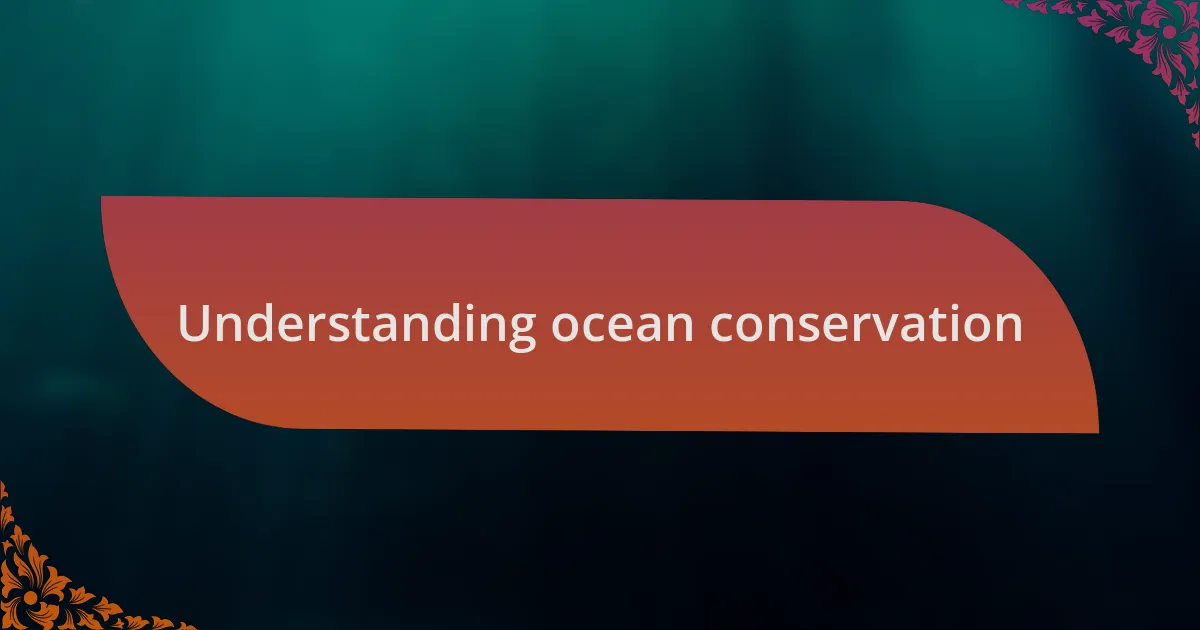
Understanding ocean conservation
Ocean conservation is more than just a trend; it’s a necessity for the health of our planet and our future. I recall a time when I stood on a beach watching the sunset, the vibrant colors painting the sky. It struck me how, despite the beauty, the ocean faced relentless threats from pollution and climate change. Have you ever considered the impact of microplastics on marine life? It’s a sobering thought that such tiny particles can affect everything from coral reefs to the fish we eat.
Understanding ocean conservation starts with recognizing its importance. For instance, coral reefs are crucial not only for their breathtaking beauty but also for the biodiversity they support and the protection they provide against coastal erosion. I remember visiting a reef and witnessing the diverse life that thrived there. It was a small ecosystem that spoke volumes about resilience, yet it was evident how fragile it truly was. Isn’t it fascinating how interconnected our actions are with the well-being of these ecosystems?
As we dive deeper into this subject, it’s essential to acknowledge our role as stewards of the ocean. Each individual action, whether reducing plastic use or supporting sustainable fishing practices, contributes to a larger cumulative effect. I often find myself questioning—how can we balance our needs with those of the ocean? This is not just a scientific concern; it’s a moral one that demands our attention and action for the sake of future generations.
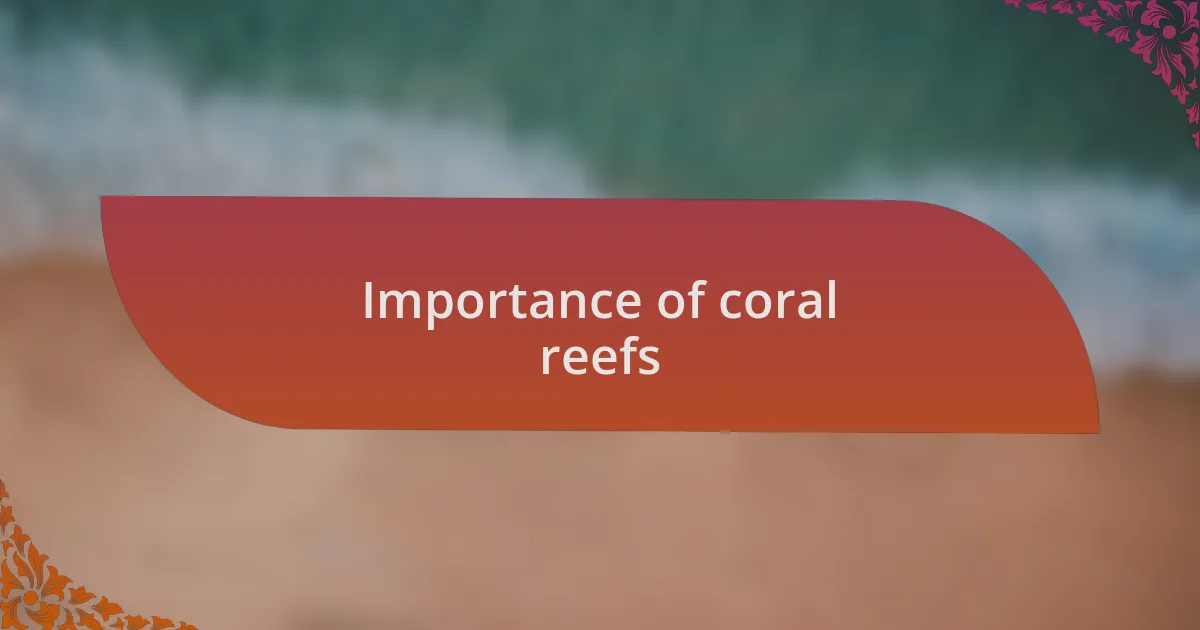
Importance of coral reefs
Coral reefs are often referred to as the “rainforests of the sea” because of the incredible biodiversity they harbor. When I first snorkeled over a coral reef, I was amazed by the variety of colors and forms of life below the surface. It felt like entering a living canvas overflowing with unique species, each playing a vital role in this underwater ecosystem. Have you ever felt that sense of wonder? It’s a reminder of how much we stand to lose if we don’t protect these fragile environments.
Moreover, coral reefs serve as natural barriers, shielding coastlines from the power of waves and storms. I vividly recall standing on the shore after a storm and seeing how much calmer the waters were closer to the reef. This protective function not only safeguards human settlements but also preserves marine habitats. It makes me consider—how many communities depend on these reefs for safety, livelihoods, and the very essence of their culture?
Finally, the economic value of coral reefs is significant, as they support fishing and tourism industries that many people rely on for their livelihoods. I once met a local fisherman who shared how his catch diminished as coral reefs declined, impacting his family’s future. Can we truly afford to ignore the economic implications of reef degradation? It’s a pressing question that reinforces the idea that coral reefs are not merely environmental assets; they’re integral to the survival and prosperity of countless lives.

Challenges facing coral ecosystems
Coral ecosystems face a multitude of challenges, and one of the most pressing is climate change. Rising ocean temperatures lead to coral bleaching, a stressful condition where corals expel the colorful algae they rely on for nutrients. I remember visiting a reef shortly after a bleaching event; the vibrant colors were replaced by ghostly white corals. It felt haunting, like an underwater graveyard, and it made me ponder the resilience of these communities and what the future might hold for them.
Additionally, ocean acidification presents a significant threat to coral reefs. As carbon dioxide levels rise in our atmosphere, more of it dissolves in ocean waters, lowering the pH and making it harder for corals to build their calcium carbonate structures. I often think back to when I interacted with marine biologists studying these acidification effects. They shared their deep concerns about the long-term implications for reef health and biodiversity. How can we expect these crucial ecosystems to survive if their very foundations are eroding?
Overfishing and destructive fishing practices further exacerbate the challenges facing these ecosystems. I’ve seen firsthand the impact of unsustainable fishing; it not only depletes fish populations but also damages the delicate balance of marine life. The underwater world I cherish so much is at risk, and it begs the question: how can we ensure that our oceans thrive rather than merely survive? Each action we take counts, and it’s imperative that we forge a collective path toward safeguarding these vital habitats.
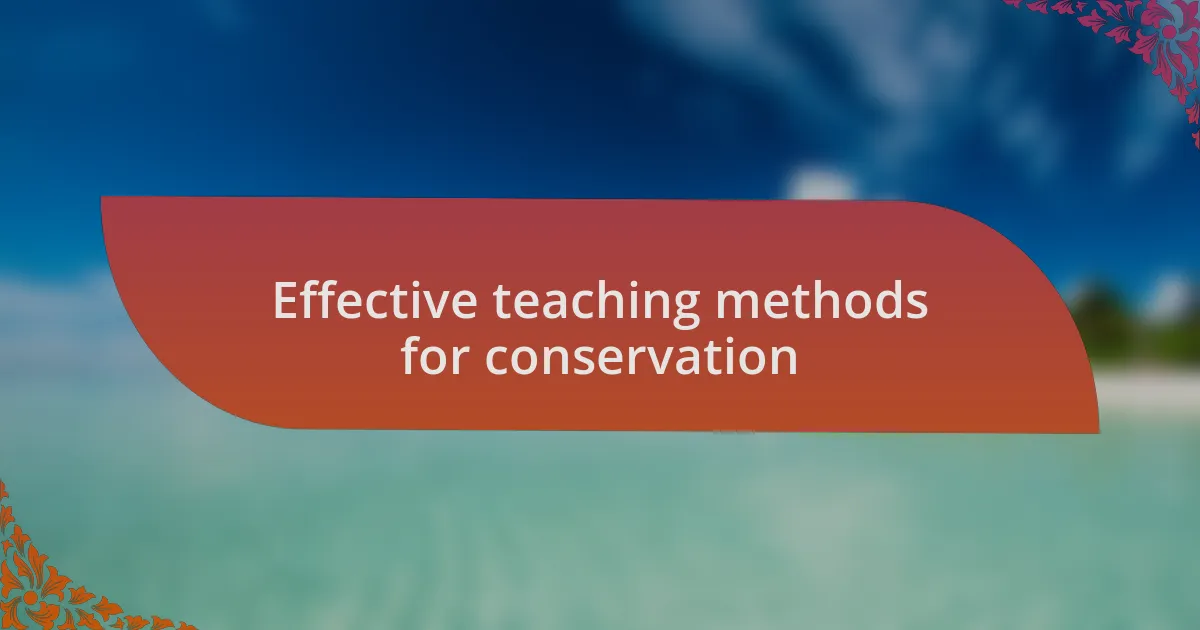
Effective teaching methods for conservation
When teaching others about ocean conservation, I find that storytelling is one of the most powerful tools at my disposal. One day, while leading a community workshop, I shared a personal experience from a diving trip that revealed the beauty and fragility of coral reefs. The audience was captivated by the vivid imagery of the colorful corals and the diverse marine life swimming among them. I saw the change in their faces—curiosity turned to determination as they began to grasp the urgency of protecting these ecosystems.
Incorporating hands-on activities can also enhance learning and retention. I often organize beach clean-ups as a practical way to teach about marine debris’ impact on reefs. It’s not just about picking up trash; it’s about connecting the dots. As we collected litter, I posed questions like, “What do you think happens to marine life when they ingest plastic?” This direct engagement transforms abstract concepts into real-life challenges, making conservation feel personal and actionable for participants.
Moreover, using visuals—like videos or images of thriving vs. damaged reefs—can create an emotional response that resonates deeply. I remember preparing a presentation for schoolchildren, where I paired stunning visuals of bustling underwater ecosystems with stark comparisons of bleached corals. The gasps I heard as they absorbed this duality underscored how crucial visuals are to sparking conversation. It left me wondering: How can such impactful moments inspire the next generation to become passionate advocates for our oceans?
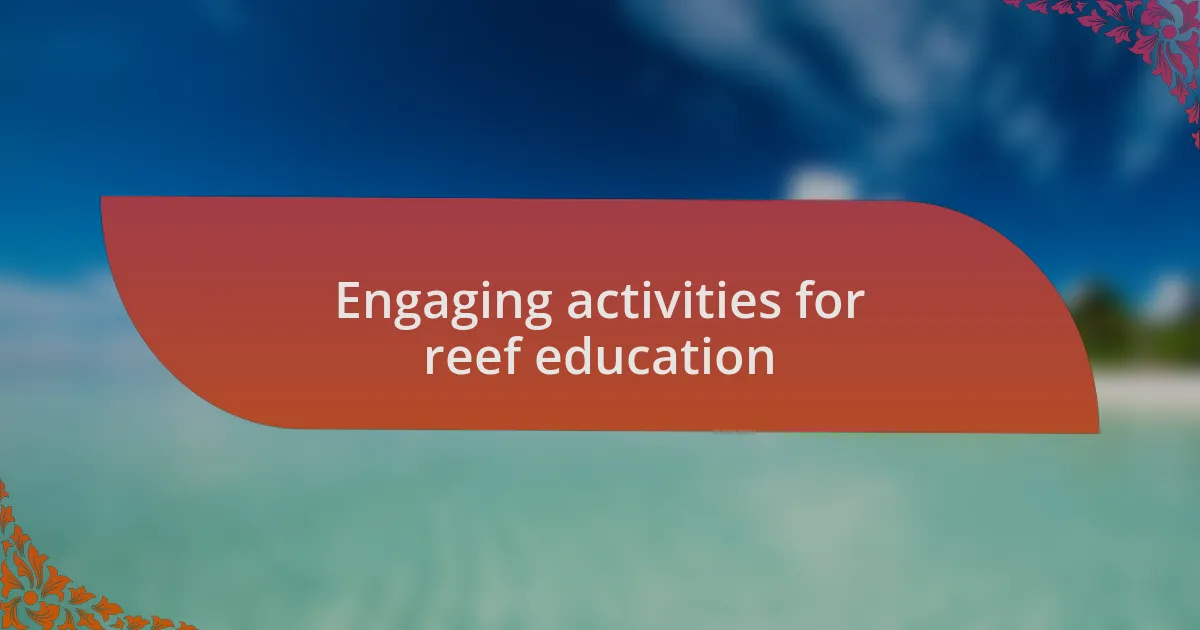
Engaging activities for reef education
One engaging activity I love is creating reef art projects. On one occasion, I hosted a workshop where participants crafted colorful coral models using recycled materials. Watching their creativity flow while discussing the unique structures of different coral species made me realize how art can bridge the gap between information and imagination. It’s fascinating to see how much more invested people become when they can express their understanding visually.
Another powerful way to teach about reefs is through interactive role-playing games. I’ll often facilitate a game where participants assume roles of various reef inhabitants, such as fish, coral, and even invasive species. This immersive experience fosters empathy; I recall a moment when someone playing a parrotfish shared how it feels to munch on algae, explaining its importance in keeping the reef healthy. It’s amazing how stepping into these roles brings theoretical concepts to life, making complex interactions feel tangible and urgent.
Lastly, organizing snorkeling or diving excursions allows individuals to experience reefs firsthand. On one trip, a participant spotted a turtle gliding gracefully and exclaimed, “This is why we fight for them!” That moment crystallized for me the joy and motivation these encounters can evoke. By connecting directly with marine ecosystems, I find that participants leave with not just knowledge but a visceral connection and a fierce commitment to conservation. Why wouldn’t we want more people to experience such transformative moments?
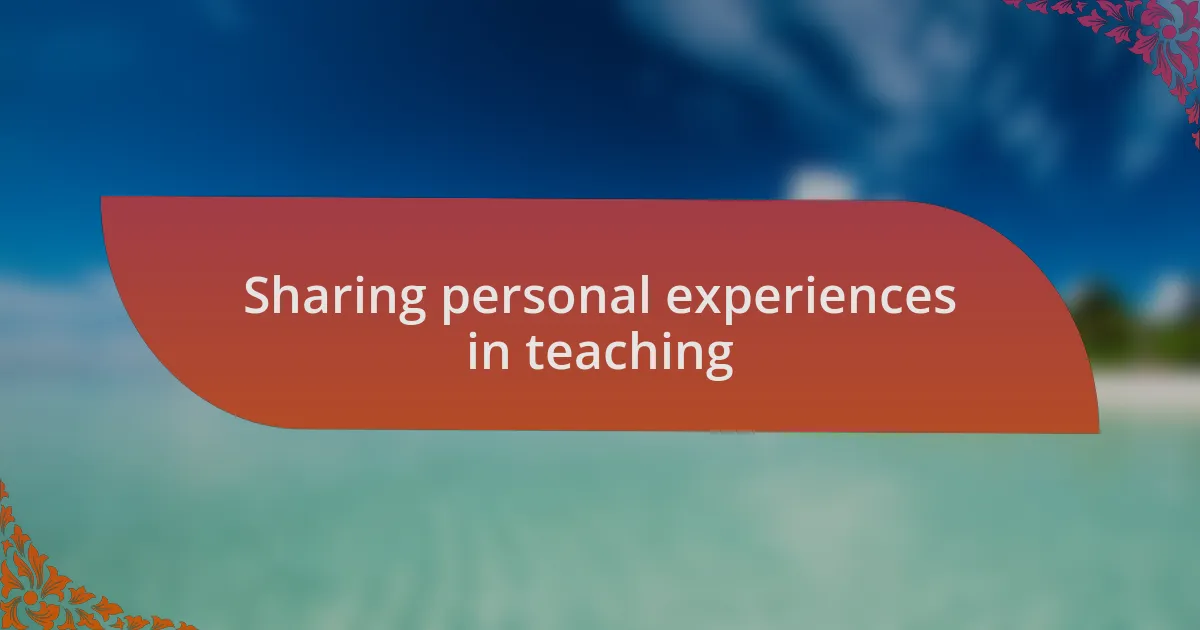
Sharing personal experiences in teaching
Teaching others about reefs has always been an incredibly rewarding journey for me. I remember one time when I was leading a group of high school students on a virtual tour of coral reefs. Their eyes widened in awe as we virtually dove deeper, revealing the vibrant colors and unique species. It struck me how powerful visual experiences can be; I could see their curiosity ignite, pushing them to ask questions and engage in discussions about reef preservation.
Another impactful teaching moment happened during a community workshop where I encouraged participants to share their thoughts after a documentary screening on coral bleaching. One elderly gentleman shared stories from his youth when the reefs were thriving and full of life. His reminiscing created a poignant atmosphere; I could sense a collective realization among attendees of what has been lost and the urgent need to act. It was a reminder of how personal stories can deepen our connection to environmental issues, making them feel more immediate and real.
Often, I find that incorporating local conservation efforts into my teaching sparks enthusiasm. Once, I partnered with a local reef restoration group, and we hosted a beach clean-up followed by an educational talk. Seeing participants transform from casual volunteers into passionate advocates as they learned about the direct impact of pollution was incredible. Moments like these reinforce my belief that teaching goes beyond facts; it’s about igniting a passion for the ocean that people carry with them, ready to inspire others in turn.